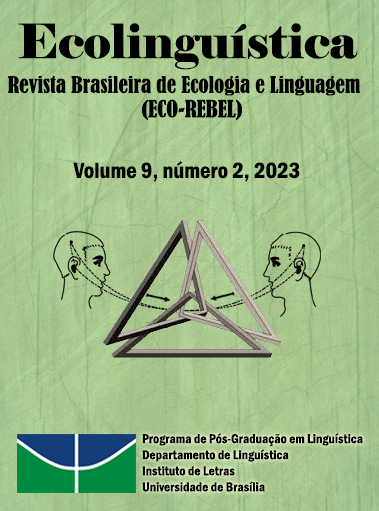A toponímia “híbrida” de Goiás: tupi e português na formação dos locativos goianos
Keywords:
Topônimos; Hibridismo; Ecossistema.Abstract
O interesse por descrever os topônimos híbridos de Goiás advém da percepção de que, ao buscar elementos linguísticos do tupi para nomear os lugares goianos, os primeiros nomeadores do território (T) goiano, revelaram uma intrínseca relação entre o povo (P) e o ambiente recém ocupado, relação essa que está na origem da motivação para dezenas de locativos de Goiás. O objetivo do estudo é então, descrever alguns desses topônimos para refletir sobre a provável impressão que o ambiente causa em P e reconhecer como os mecanismos linguísticos de formação de palavras se encaixam na tradução dessas motivações. Para tanto, pauta-se nos trabalhos de Cabrera (2002), Mexias-Simon (s/d), Pocklington (s/d), Siqueira (2022) e em, Couto (2007), (2015). A metodologia caracteriza-se pela revisão bibliográfica, consulta a documentos e interpretação dos dados sob viés ecossistêmico. Inicialmente, podem ser relacionados os topônimos híbridos (por derivação ou composição) Goiânia, Campinaçu, Nova Crixás para citar alguns.
Downloads
Published
Issue
Section
License

This work is licensed under a Creative Commons Attribution-NonCommercial-NoDerivatives 4.0 International License.
Authors who publish in this journal agree to the following terms:
Authors retain copyright and grant the journal the right of first publication. The work is simultaneously licensed under the Creative Commons Attribution License allowing the sharing of the work with acknowledgment of the authorship of the work and initial publication in this journal.
Authors are authorized to enter into additional contracts separately for non-exclusive distribution of the version of the work published in this journal (e.g., publishing in institutional repositories or as book chapters), with acknowledgment of authorship and initial publication in this journal.
Authors are allowed and encouraged to post and distribute their work online (e.g., in institutional repositories or on their personal page) at any point before or during the editorial process, as this can bring about productive revisions as well as increase impact.
Citation of published works (See The Effect of Free Access).



3.png)



